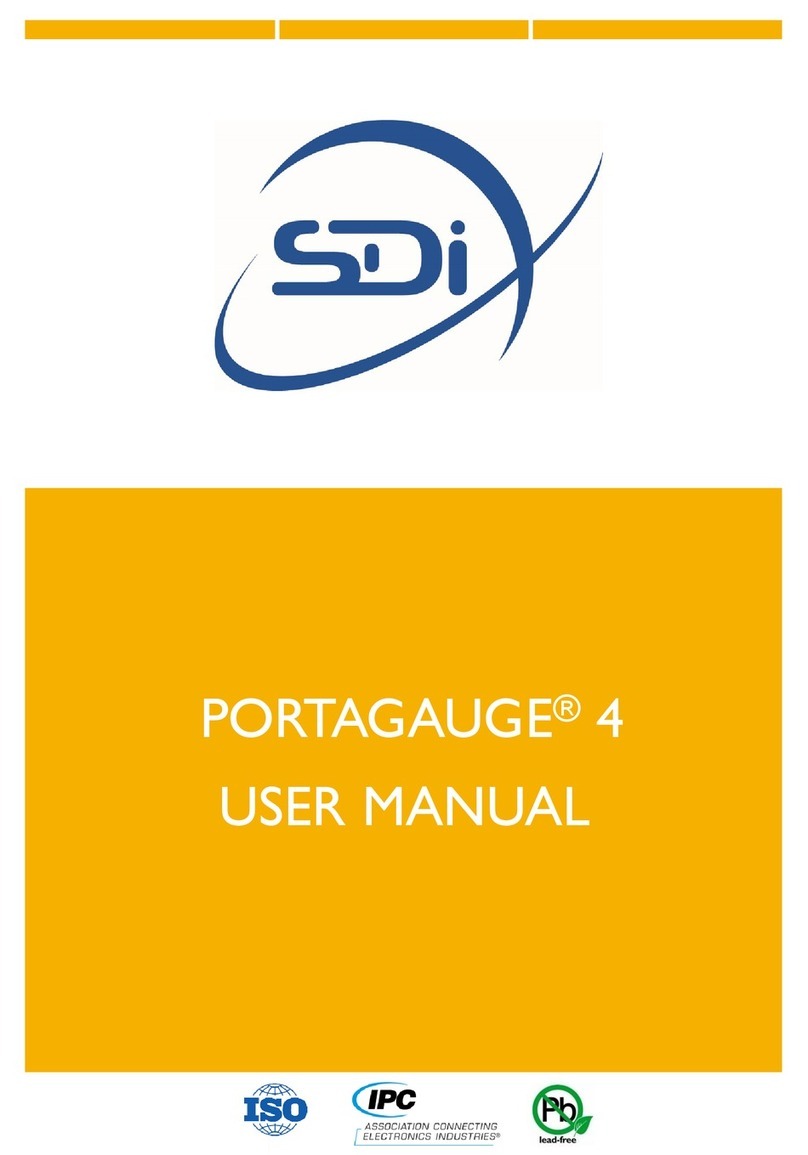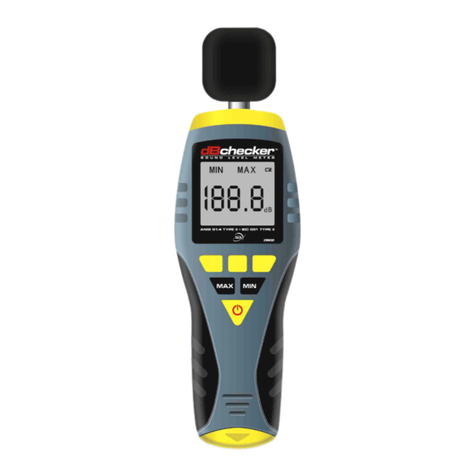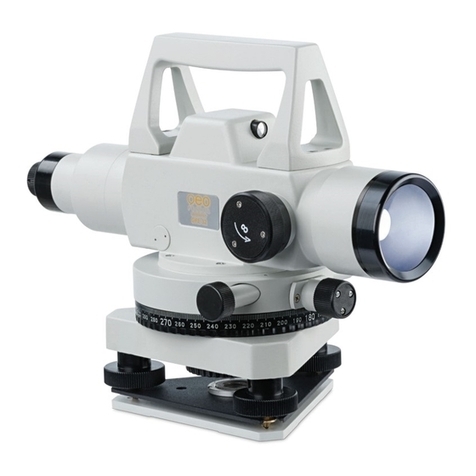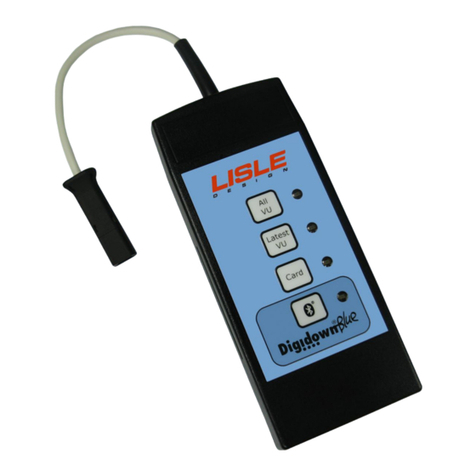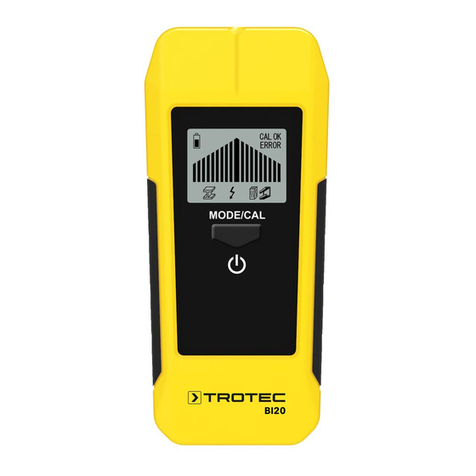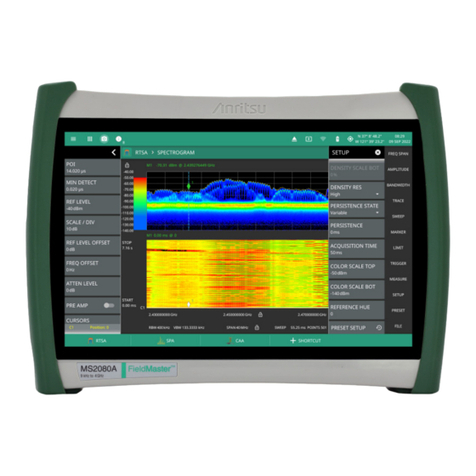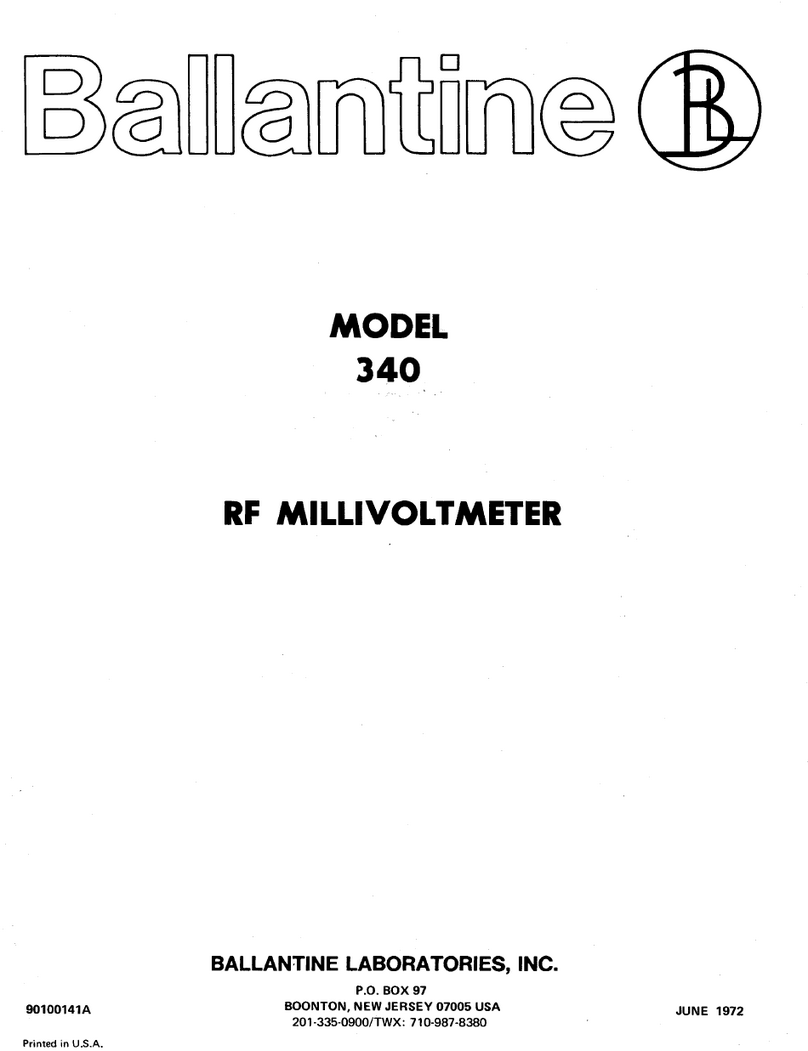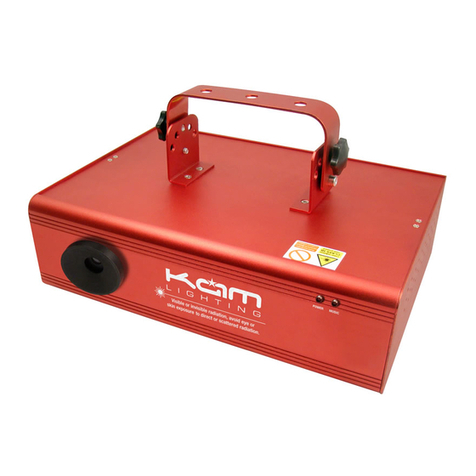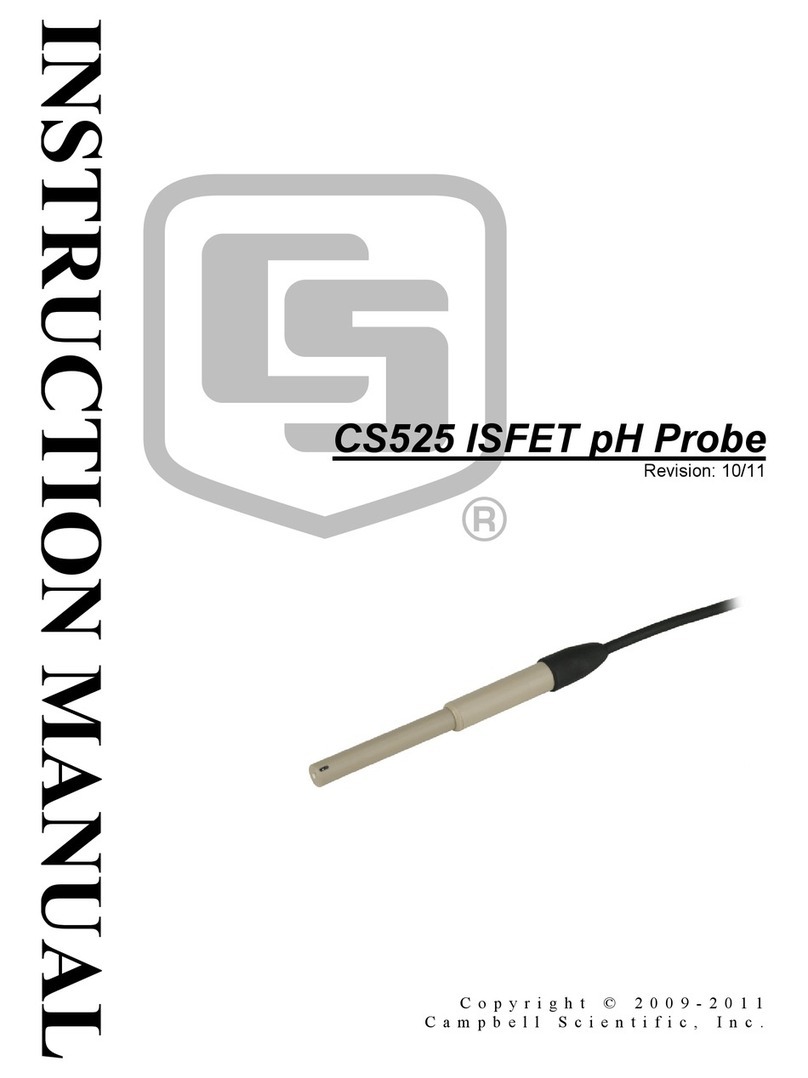SDI NMSC-2 User manual

NMSC-2
Quick Start Guide

2
SDI
Table of Contents
Introduction………...……...………………………………………….. 3
Hardware Installation…...……………………………………………. 4
Quick Start Guide…………………………………………………….. 7
Sample results ……………………………………………………….. 19

3
SDI
Introduction
The Noise Measurement System is a modular instrument that may be
customized to implement a versatile dual-channel noise measurement system. The
measurement system may be used to make both AM and PM noise measurements on
signals in the frequency range of 1 MHz to 45 GHz. Custom detector modules may be
added to extend the carrier frequency measurement range. The measurement system
is composed of modules that plug into the measurement system instrument crate. The
instrument crate dimensions are 5U X 19” X 16”. The instrument crate is included with
the purchase of a Noise Measurement System Controller (NMSC).
The NMSC-2 module contains a dual-channel spectrum analyzer. Dual channel
cross-correlation measurement techniques can be used to measure signals that are
lower than the system noise floor. The front panel has a 6.4 inch XGA color touch-
screen display. An external keyboard, monitor and printer can also be connected to the
controller. Remote measurements or monitoring are possible using the Windows XP
remote desktop software and an Ethernet connection.
There are six slots available on the noise measurement crate for the various
measurement modules. Two noise detector module series are currently offered that
cover the frequency range of 1 MHz to 45 GHz. The ND-1 series of modules covers
the frequency range of 1 MHz to 1 GHz. The ND-3 series of modules covers the
frequency range of 1 GHz to 45 GHz. Custom modules may be ordered to extend the
frequency range or implement special measurement topologies. All the noise detector
modules are designed to facilitate the measurement of sources as well as passive and
active components. For source measurements, the reference and device under test
are phase locked with programmable PLL bandwidth to accommodate measurements
of wide tuning voltage controlled oscillators to very stable ultra-low noise oven
stabilized oscillators. Noise in amplifiers, multipliers, mixers and other active and
passive components can be measured easily with the addition of one of the
programmable delay line modules.
Calibration of the Noise Measurement System can be accomplished easily
using a noise source module, NS-NM or a tone calibration module, TC-NM. The
system can also be calibrated by using the traditional beat note calibration method.
Calibrated noise source modules and tone calibration modules can be ordered for any
frequency range of interest.

4
SDI
Hardware Installation
NMS INSTRUMENT CRATE DESCRIPTION
The NMS Instrument Crate is a NIM (Nuclear Instrumentation Module) standard
crate that has been configured to provide communication busses and power for the
Noise Measurement System Controller (NMSC) and Noise Detector Modules. Using
NIM modules not specifically designed for the Crate is not recommended and could
result in damage to the system.
The left front mounting plate of the crate contains the crate power switch and
power LED. Modules are installed onto the front of the crate by means of 12 nylon
guiding rails. There are 12 module spaces, however the NMS controller will occupy the
first six spaces, leaving six spaces for various Detector modules. Each module has two
or more thumb screws that secure it to the NMS Instrument Crate. The NMS Modules
are not “hot swappable”. This means that NMS Instrument Crate power supply needs
to be turned off, before removing or inserting any modules. This can be done by
turning the front panel power switch to the off position.
The NMS Controller must be installed into leftmost six spaces. Not doing so will
result in damage to the modules, and or controller. The rest of the spaces on the NMS
Crate can contain any of the detector, or synthesizer modules provided by
SpectraDynamics Inc.
The back of the NMS Instrument Crate has two circular power connectors and
LED indicators. The 14 pin connector delivers power to the NIM Modules while the 24
pin connector delivers power to the NMSC-2 controller.
NMS RACKMOUNT INSTALLATION
The NMS is designed to be rack mounted on standard 19" wide racks. The
NMS Crate has 5U non-removal rack mount handles, while the external power supply
has removable 2U rack handles. It is important that there is enough clearance behind
the NMS Crate and DC Power Module for proper air circulation. Blocking any fan
exhaust could cause the system to fail due to a thermal overload.
NMS BENCHTOP INSTALLATION
The NMS also supports tabletop operation. Four rubber feet are included with
the NMS Crate. These attach to the bottom of the crate and should only be used for
tabletop operation. Enough clearance behind the NMS Crate and DC Power Module is
necessary for proper air circulation. Blocking any fan exhaust could cause the system
to fail due to a thermal overload.

5
SDI
Hardware Installation
NMS POWER SUPPLY INSTALLATION
The DC Power Module must be placed as far away from the NMS Instrument
Crate as possible. The power cables that are provided with the system are 8 feet in
length and must be securely connected to their mating connectors. The 24 wire cable
delivers power to the controller, while the 14 wire cable delivers power to the crate.
Once the DC and ATX power cables are connected, the DC Power Module must be
turned on. The Master Power Switch is located on the rear of the DC Power Module.
CAUTION! DO NOT TURN OFF THE MASTER SWITCH UNLESS POWER TO THE
NMSC-2 CONTROLLER AND THE NMS CRATE IS TURNED OFF. Turning this
switch off will immediately cut power to the computer and the NMS Instrument Crate.

6
SDI
Hardware Installation
NMSC MODULE INSTALLATION
The NMS Controller is the heart of the noise measurement system. It is
composed of a Pentium Dual Core based computer and a high-speed digitizer. It also
has a resistive touch screen LCD. The Windows XP operating system was chosen
because of its popularity. The front panel also contains a standard USB 2.0 connector
and the NMSC power button. It is important not to use the NMSC controller as a
general-purpose computer since processor intensive applications will not allow the
noise measurement software to execute properly.
The back panel contains most of the input/output ports. There are four USB, two
serial, one firewire, one keyboard ,one mouse, one LAN and one parallel port that can
be used to connect to other peripherals such as printers, portable hard drives, etc.
There are also VGA, optical and audio connectors that can be used to connect to
external multimedia devices. The digitizer input and output ports are also located at the
back of the module. The Detector module output ports need to be connected to the
digitizer input ports before any measurement can be made.
The NMS Controller module slides into the first six module spaces of the NMS
Instrument Crate. There are 4 thumb screws that bolt the module in place. If a mouse,
keyboard or external display are to be used, these must be connected to the module
before turning the power on. Once the NMS Controller is in place, pressing the power
button will turn the computer on. Please be aware that turning the Master Power
Switch off while the computer is running could cause the computer hard drive to fail.
NOISE DETECTOR MODULE INSTALLATION
A variety of noise detector modules are available from SpectraDynamics Inc.
These modules can be installed into any of the six spaces to the right of the NMS
Controller. To install a module, slide the module into any of the six guiding rails and
bolt the module in place using the thumb screws attached to the front panel of the
module.
Once all modules are installed power may be applied to the NMS Crate by
turning on the "DC POWER" switch located on the front of the NMS Crate.

7
SDI
Quick Start Guide
INTRODUCTION
The purpose of the quick start guide is to go through the steps necessary to
make a single channel measurement. Most of the major functions in the software have
a quick description explaining their function. To access the quick description just point
the mouse or pointer to the button or tab and leave the pointer on the object for a few
seconds.
NMSC POWER ON
The NMSC-2 Controller has a POWER ON button on the front panel just below
the screen. The NMSC POWER ON button only powers the NMSC controller and will
not turn on power to the instrument crate. To apply power to any of the detectors you
must turn on the Chassis DC POWER SWITCH located on the lower left hand corner
of the chassis.
To turn on the NMSC controller press the POWER ON button. The NMSC
controller will boot up to a Windows XP screen. The measurement software
executables are under the C:\NMSC-2 directory. There will be a NMSC shortcut icon
on the desktop. Click on the icon to run the measurement system software.
NMSC CHASSIS POWER ON
The power to the noise detectors is supplied through the instrument crate. Make
sure that the crate power is OFF when a noise detector is inserted or extracted from
the system. THE NOISE DETECTORS ARE NOT HOT PLUGGABLE. The chassis
power is independent of the NMSC controller power and this power may be switched
on/off even when the measurement system software is running.

8
SDI
Quick Start Guide
The NMSC software will load to an initial screen with the name of the software
and the company name. Once the system initializes it will change to the FFT
measurement screen shown below.

9
SDI
Quick Start Guide
ASSIGN THE NOISE DETECTORS TO A MEASUREMENT CHANNEL
On the bottom of the FFT screen there is a series of tabs that access different
control pages. Select the tab marked Detector to access the Noise Detector Setup
Page. The following page will appear.
Press the ASSIGN DETECTOR button.
The assign detector screen will open.

10
SDI
Quick Start Guide
Press the SCAN button.
This will scan the chassis for available noise detectors. The model number and
frequency range of the detectors should appear in the corresponding bin position on
the screen. Use the drop down selection button to select a Noise detector to be used
on Channel 1 of the system and if more than one detector is installed you may select
the Noise detector that is to be assigned to Channel 2 of the system.
Press the EXIT button once you have made your selection.
CONNECT RF CABLES
Once the detectors are assigned to a measurement channel make sure to
connect the IF OUTPUT of the detector to the NMSC controller CH 1 or CH 2 inputs
(as selected) on the rear of the NMSC controller. Make sure to use the supplied BNC
cables that have the ferrite bead clamped on the cable. The ferrite beads are essential
for low noise measurements.

11
SDI
Quick Start Guide
SETUP ND-1 DETECTORS
The Noise Detector software configuration is set by
pressing the CH 1 DETECTOR or CH 2 DETECTOR
button, this will bring up the Noise Detector setup window
shown below.
The ND-1 Noise Detector setup
window has three pages that are accessed
by pressing the NEXT button. The window
has four digital indicators that display the
internal Mixer voltage, the IF output
voltage and the PLL output voltage. The
fourth indicator displays the frequency of
the IF signal when a beat signal is present.
RF SETTINGS
The main page shows the RF
measurement capability of the detector
and will show any available RF control
settings.
IF SETTINGS
The second page will show the IF
settings available for the selected Noise
Detector. The main buttons on this page
control the IF bandwidth, IF gain, DC or
AC coupling of the IF amplifier and
selection of the input to the IF amplifier.
The input to the IF amplifier can either be
the internal mixer or an external signal
which must be applied to the CAL input
connector on the front panel.

12
SDI
Quick Start Guide
CONNECT THE RF SIGNAL TO THE NOISE DETECTORS
All noise detectors will have the following four SMA connectors on the front panel.
The RF1 connector is the LO input to the internal mixer.
The RF2 connector is the RF input to the internal mixer.
The PLL OUT connector provides the PLL control voltage that should be connected to
the tuning port of the oscillator. The PLL control voltage can be selected to go
from –5V to +5V or it can be selected for single supply operation 0 to +5V. Make
sure to select the appropriate voltage range to avoid damaging the oscillator
tuning port. The impedance of the tuning port is 50-Ohm.
The CAL connector is the input to the IF amplifier when the Noise Detector is in EXT
mixer mode.
The maximum RF levels and the frequency range of the detector are shown on the
Noise Detector RF settings window. Use of signals that are out of the range of the
Noise Detector may result in damage to the internal mixer.
PLL SETTINGS
The third page shows the phase
lock controls of the selected noise
detector. The PLL parameters can be
selected and the PLL can be activated or
turned off. The PLL parameters are set
from the user supplied information such
as the PLL locking bandwidth, the
sensitivity of the tuning port and the
sensitivity of the mixer.
Measurements cannot be started
or stopped while the noise detector
settings window is active. You can exit
this window by pressing the EXIT button.

13
SDI
Quick Start Guide
Below is a block diagram of a typical single channel phase noise measurement for two
oscillators.
NMSC Noise Detector RF1
RF2
PLL
REF OSC
DUT OSC
Optional
PRI FILTER
Channel 1
USE DETECTOR SETUP WINDOW AGAIN
Once the RF signals are connected to the noise detector you may want to open
the DETECTOR SETUP window again to adjust the PLL parameters or check the IF
output voltage or the mixer voltage. The mixer voltage should be 0 volts for phase
noise measurements. If amplitude noise measurements are desired the phase of the
RF signals should be set to maximize absolute value of the mixer voltage. AM meas-
urements can also be made by using an AM detector attached to the CAL port on the
front panel of the noise detector.

14
SDI
Quick Start Guide
SET INPUT RANGE OF THE NMSC-2
Once the RF signals are adjusted for your particular measurement. Select the
SETUP tab on the bottom of the FFT screen to adjust the input range of the digitizer in
the controller.
Note that you may also select the input impedance and the type of coupling used for
the measurement. All noise detectors have a 50-ohm output so if the CH1 or CH2
inputs on the controller are connected to a noise detector, the impedance selection
should be 50-ohm and the coupling should be set to DC.

15
SDI
Quick Start Guide
The bandwidth of the analyzer for different settings is shown below.
Impedance Coupling Bandwidth
50 DC DC - 40 MHz
50 AC 100 kHz – 40 MHz
1 M DC DC – 40 MHz
1 M AC 10 Hz – 40 MHz
Most amplitude and phase noise measurements can be made using the 50-ohm
impedance and DC coupling on the analyzer. If you need to make AC coupled
measurements you should first try setting up the Noise Detector to AC coupled
operation. Selecting the input range of the analyzer can be done manually or by
turning on the AUTORANGE function.
The AUTORANGE function enables a range finding operation at the beginning
of each measurement.
The RANGE button will do a single range finding operation.
SELECT FREQUENCY RANGE FOR THE MEASUREMENT
The NMSC-2 built in analyzer can perform Fast Fourier analysis from 0.1Hz to
40MHz. Click on the SET FREQ button to access the frequency selection dialog
window.
Set the lower and upper
frequency bounds for the desired
FFT. Once you are finished click
on the DONE button.

16
SDI
Quick Start Guide
SELECT AVERAGING PARAMETERS
The FFT analysis for the chosen frequency range is done in multiple spans. One
span will typically cover one decade in frequency. Different number of averages can
be chosen for the different frequency spans using the SET AVERAGE function, which
will bring up the NUMBER OF AVERAGES window.
The numerical keypad is used to type in the number of averages for a selected span.
To change the number of averages for a span, first type in the desired number, then
click on the desired span button.
Alternatively you can click on the ALL button to set all span averages to the desired
number.

17
SDI
Quick Start Guide
Press the DONE button to exit the average setup window.
PRESS START
Press the START button to initiate a measurement.
PRINT
Once the measurement is done, press the PRINT button to print the
measurement or to save the data to a file.
TURN OFF THE MEASUREMENT SYSTEM
To turn off the measurement system exit the software and press the green
POWER BUTTON. This action will initiate a shutdown of the operating system and of
the NMSC. The power to the chassis can be turned off using the chassis DC POWER
switch.
The RMS averaging function can be turned on or off using the RMS ON/OFF button.
The type of FFT window can be selected by clicking on the WINDOW button.
There is also a button that allows you to select between a linear weighted average and
an exponentially weighted average.

18
SDI
Software Overview
The Measurement System Software has two modes of operation FFT mode and
SCOPE mode. In FFT mode the noise signals are analyzed in the frequency domain
by digitizing the signals, applying a window function on the digitized data and then
performing an FFT on the data. The resulting analysis is displayed on a plot of
amplitude vs frequency. All the hardware settings and analysis parameters can be set
using controls and dialog boxes on the FFT Window. In SCOPE mode the noise
signals are analyzed in the time domain and the digitized data is displayed in a plot of
amplitude vs time. The hardware setting and measurement parameters and options
are set using controls and dialog boxes on the SCOPE Window.
The measurement results can be saved to ascii data files, saved to a report in
Microsoft Word format, or saved as measurement trace files. The ascii data can readily
be imported into other spreadsheet programs. The reports contain all the measurement
data in a chart as well as a data table that are easily modified or formatted. The
measurement trace files are in a special format that allows a user to recall into the
measurement system software previously saved data. This feature allows for
comparison of past measurement with measurements that are currently being taken.
A detailed explanation of the NMSC Software is given in the NMSC User
Manual. Information on individual Noise Detector Modules will be found in the
operation manuals for those modules.

19
SDI
Sample Results
A sample of the plots produced by the measurement system software is shown
below. The plot contains the result of a noise floor measurement using the ND-3-NM
Noise Detector. The carrier frequency was 9200 MHz and the amplitude of the signals
was 10 dBm.
9200 MHz PM Noise Floor
-180.0
-170.0
-160.0
-150.0
-140.0
-130.0
-120.0
-110.0
-100.0
-90.0
-80.0
1.00E+00 1.00E+01 1.00E+02 1.00E+03 1.00E+04 1.00E+05 1.00E+06 1.00E+07 1.00E+08
Frequency
Amplitude (dBc/Hz)
CH 1
Table of contents
Other SDI Measuring Instrument manuals
